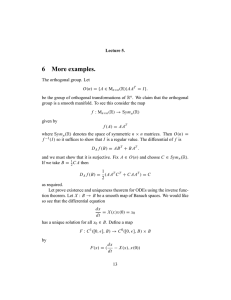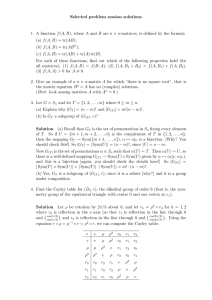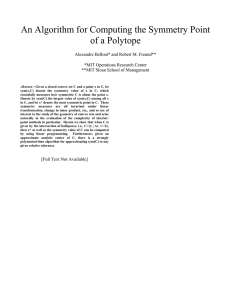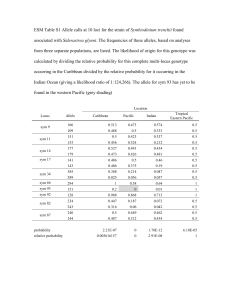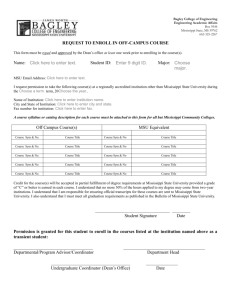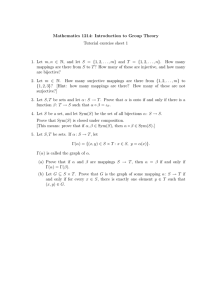Multi-Loop Miracles in N=4 Super-Yang-Mills Theory
advertisement
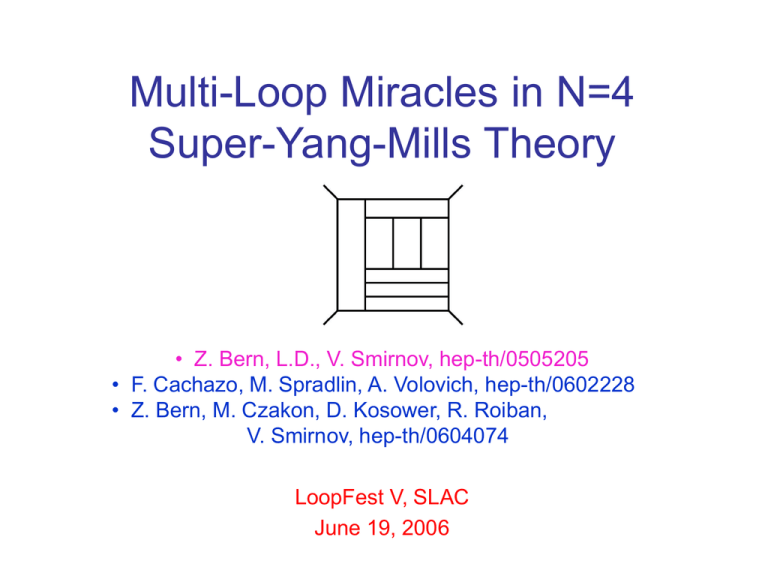
Multi-Loop Miracles in N=4 Super-Yang-Mills Theory • Z. Bern, L.D., V. Smirnov, hep-th/0505205 • F. Cachazo, M. Spradlin, A. Volovich, hep-th/0602228 • Z. Bern, M. Czakon, D. Kosower, R. Roiban, V. Smirnov, hep-th/0604074 LoopFest V, SLAC June 19, 2006 Outline • N=4 SYM and AdS/CFT • Use of unitarity to construct N=4 SYM amplitude integrands • Exponentiated infrared structure of amplitudes and Sudakov form factors • Exponentiation of full amplitudes (including IR finite terms) in planar N=4 SYM at 2 and 3 loops • “Leading transcendentality” connection between terms in QCD and N=4 SYM • Conclusions June 19, 2006 L. Dixon Multi-loop Miracles in Planar N=4 SYM 2 N=4 SYM, AdS/CFT and perturbative scattering • • • • N=4 SYM is most supersymmetric theory possible without gravity Uniquely specified by gauge group, say SU(Nc) Exactly scale-invariant (conformal) field theory: b(g) = 0 AdS/CFT duality suggests that weak-coupling perturbation series for planar (large Nc) N=4 SYM should have special properties: – strong-coupling limit equivalent to weakly-coupled gravity theory • Some quantities are protected, unrenormalized, so the series is trivial (e.g. energies of BPS states) • Scattering amplitudes (near D=4) are not protected – how does series organize itself into a simple result, from gravity point of view? June 19, 2006 L. Dixon Multi-loop Miracles in Planar N=4 SYM 3 N=4 SYM particle content SUSY Qa, a=1,2,3,4 shifts helicity by 1/2 June 19, 2006 L. Dixon Multi-loop Miracles in Planar N=4 SYM 4 N=4 SYM interactions All proportional to same dimensionless coupling constant, g • SUSY cancellations: scale invariance preserved quantum mechanically ~ g s June 19, 2006 L. Dixon Multi-loop Miracles in Planar N=4 SYM 5 Perturbative Unitarity • S-matrix is a unitary operator between in and out states • Expand T-matrix in g Unitarity relations (cutting rules) for amplitudes • Very efficient due to simple structure Bern, LD, Dunbar, of tree helicity amplitudes Kosower (1994) June 19, 2006 L. Dixon Multi-loop Miracles in Planar N=4 SYM 6 Unitarity and N=4 SYM • Many higher-loop contributions to gg -> gg scattering can be deduced from a simple property of the 2-particle cuts at one loop Bern, Rozowsky, Yan (1997) • Leads to “rung rule” for easily computing all contributions which can be built by iterating 2-particle cuts June 19, 2006 L. Dixon Multi-loop Miracles in Planar N=4 SYM 7 “Iterated 2-particle cut-constructible contributions” For example, the coefficient of this topology is easily computable from the rung rule More concise terminology: (planar) Mondrian diagrams June 19, 2006 L. Dixon Multi-loop Miracles in Planar N=4 SYM 8 Simplicity of N=4 SYM 4-point amplitudes • 1 loop: Green, Schwarz, Brink (1982) “color dresses kinematics” planar • 2 loops: Bern, Rozowsky, Yan (1997); Bern, LD, Dunbar, Perelstein, Rozowsky (1998) • Analogous computation in QCD not completed until 2001 Glover, Oleari, Tejeda-Yeomans (2001); Bern, De Freitas, LD (2002) June 19, 2006 L. Dixon Multi-loop Miracles in Planar N=4 SYM 9 Three loop planar amplitude • 3-loop planar diagrams (leading terms for large Nc): BRY (1997); BDDPR (1998) (3-particle cuts also checked) • 3-loop non-planar result includes non-Mondrian diagrams – not completed yet June 19, 2006 L. Dixon Multi-loop Miracles in Planar N=4 SYM 10 IR Structure of QCD and N=4 SYM Amplitudes • Expand multi-loop amplitudes in d=4-2e around d=4 (e=0) • Overlapping soft + collinear divergences at each loop order imply leading poles are ~ 1/e2L at L loops • Pole terms are predictable, up to constants, for QCD & N=4 SYM, due to soft/collinear factorization and exponentiation Mueller (1979); Collins (1980); Sen (1981); Sterman (1987) Catani, Trentadue (1989); Korchemsky (1989) Magnea, Sterman (1990) ; Korchemsky, Marchesini, hep-ph/9210281 Catani, hep-ph/9802439 ; Sterman, Tejeda-Yeomans, hep-ph/0210130 • Surprise is that, for planar N=4 SYM (only), the finite (e0) terms also exponentiate! June 19, 2006 L. Dixon Multi-loop Miracles in Planar N=4 SYM 11 Soft/Collinear Factorization Akhoury (1979); Sen (1983); Botts, Sterman (1989); Magnea, Sterman (1990); Sterman, Tejeda-Yeomans, hep-ph/0210130 • S = soft function (only depends on color of ith particle) • J = jet function (color-diagonal; depends on ith spin) • hn= hard remainder function (finite as ) June 19, 2006 L. Dixon Multi-loop Miracles in Planar N=4 SYM 12 Simplification at Large Nc (Planar Case) • Soft function only defined up to a multiple of the identity matrix in color space • Planar limit is color-trivial; can absorb S into Ji • If all n particles are identical, say gluons, then each “wedge” is the square root of the “gg -> 1” process (Sudakov form factor): June 19, 2006 L. Dixon Multi-loop Miracles in Planar N=4 SYM 13 Sudakov form factor • By analyzing structure of soft/collinear terms in axial gauge, find differential equation for form factor : Mueller (1979); Collins (1980); Sen (1981); Korchemsky, Radyushkin (1987); Korchemsky (1989); Magnea, Sterman (1990) finite as e-> 0; contains all Q2 dependence Pure counterterm (series of 1/e poles); like b(e,as), single poles in e determine K completely K, G also obey differential equations (ren. group): June 19, 2006 L. Dixon Multi-loop Miracles in Planar N=4 SYM soft or cusp anomalous dimension 14 Sudakov form factor (cont.) • Solution to differential equations for : • N=4 SYM: b=0, so as(m) = as = constant, Running coupling in d=4-2e has only trivial (engineering) dependence on scale m : which makes it simple to perform integrals over June 19, 2006 L. Dixon Multi-loop Miracles in Planar N=4 SYM 15 Sudakov form factor in planar N=4 SYM • Expand in terms of • Perform integrals over June 19, 2006 L. Dixon Multi-loop Miracles in Planar N=4 SYM 16 General amplitude in planar N=4 SYM Insert result for form factor into which we can rewrite as this looks like the one-loop amplitude, but with e shifted to (l e), up to finite terms where “mixes” with hn(l) with June 19, 2006 L. Dixon Multi-loop Miracles in Planar N=4 SYM 17 Exponentiation in planar N=4 SYM • Miracle: In planar N=4 SYM the finite terms also exponentiate. That is, the hard remainder function hn(l) defined by is also a series of simple constants, C(l) [for MHV amplitudes]: where Evidence based so far on two loops (n=4,5, plus collinear limits) and three loops (for n=4) In contrast, for QCD, and non-planar N=4 SYM, two-loop amplitudes have been computed, and the hard remainders are a polylogarithmic mess! June 19, 2006 L. Dixon Multi-loop Miracles in Planar N=4 SYM 18 Exponentiation at two loops • The general formula, implies at two loops: • To check at n=4, need to evaluate just 2 integrals: Smirnov, hep-ph/0111160 elementary June 19, 2006 L. Dixon Multi-loop Miracles in Planar N=4 SYM 19 Two-loop exponentiation & collinear limits • Evidence for n>4: Use limits as 2 momenta become collinear: • Tree amplitude behavior: • One-loop behavior: • Two-loop behavior: June 19, 2006 L. Dixon Multi-loop Miracles in Planar N=4 SYM 20 Two-loop splitting amplitude iteration • In N=4 SYM, all helicity configurations are equivalent, can write • Two-loop splitting amplitude obeys: Anastasiou, Bern, LD, Kosower, hep-th/0309040 Consistent with the n-point amplitude ansatz and fixes n-point information required to separate these two June 19, 2006 L. Dixon Multi-loop Miracles in Planar N=4 SYM 21 Exponentiation at three loops • L-loop formula implies at three loops • To check at n=4, need to evaluate just 4 integrals: Smirnov, hep-ph/0305142 Use Mellin-Barnes integration method elementary June 19, 2006 L. Dixon Multi-loop Miracles in Planar N=4 SYM 22 Harmonic polylogarithms • Integrals are all transcendental functions of • Expressed in terms of harmonic polylogarithms (HPLs) with indices , defined recursively by: Remiddi, Vermaseren, hep-ph/9905237; Gehrmann, Remiddi, hep-ph/0107173; Vollinga, Weinzierl, hep-ph/0410259 number of indices = weight w with • For w = 0,1,2,3,4, these HPLs can all be reduced to ordinary polylogarithms, • But here we need w = 5,6 too June 19, 2006 L. Dixon Multi-loop Miracles in Planar N=4 SYM 23 Exponentiation at three loops • Inserting the values of the integrals (including those with and using HPL identities relating we verify the relation, and extract ) into , etc., n-point information still required to separate June 19, 2006 L. Dixon Multi-loop Miracles in Planar N=4 SYM 24 “Leading transcendentality” relation between QCD and N=4 SYM • KLOV (Kotikov, Lipatov, Onishschenko, Velizhanin, hep-th/0404092) noticed (at 2 loops) a remarkable relation (miracle) between kernels for: • BFKL evolution (strong rapidity ordering) • DGLAP evolution (pdf evolution = strong collinear ordering) in QCD and N=4 SYM: • Set fermionic color factor CF = CA in the QCD result and keep only the “leading transcendentality” terms. They coincide with the full N=4 SYM result (even though theories differ by scalars) • Conversely, N=4 SYM results predict pieces of the QCD result • “transcendentality”: June 19, 2006 L. Dixon 1 for p n for zn = Lin(1) similar counting for HPLs and for related harmonic sums used to describe DGLAP kernels Multi-loop Miracles in Planar N=4 SYM 25 3-loop DGLAP splitting functions P(x) in QCD Related by a Mellin transform to the anomalous dimensions g(j) of leading-twist operators with spin j • Computed by MVV (Moch, Vermaseren, Vogt, hep-ph/0403192, hep-ph/0404111) • KLOV obtained the N=4 SYM results by keeping only the “leading transcendentality” terms of MVV June 19, 2006 L. Dixon Multi-loop Miracles in Planar N=4 SYM 26 3-loop planar N=4 amplitude checks QCD • From the value of the 1/e2 pole in the scattering amplitude, we can check the KLOV observation, plus the MVV computation, in the large-spin j limit of the leading-twist anomalous dimensions g(j) ( limit of the x-space DGLAP kernel), also known as the soft or cusp anomalous dimension: or Korchemsky (1989); Korchemsky, Marchesini (1993) where June 19, 2006 L. Dixon Multi-loop Miracles in Planar N=4 SYM 27 3-loop planar N=4 check (cont.) only 4 integrals required June 19, 2006 L. Dixon Multi-loop Miracles in Planar N=4 SYM 28 3-loop planar N=4 check (cont.) • 1/e pole is sensitive to G in Sudakov form factor. • We can apply KLOV’s prescription here as well, to predict the leading transcendentality terms in the three-loop QCD form factor: • Prediction confirmed by MVV (hep-ph/0508055) June 19, 2006 L. Dixon Multi-loop Miracles in Planar N=4 SYM 29 Integrability & anomalous dimensions • The dilatation operator for N=4 SYM, treated as a Hamiltonian, is integrable at one loop. • E.g. in SU(2) subsector, tr( ZL Xj ), it is a Heisenberg model Minahan, Zarembo, hep-th/0212208; Beisert, Staudacher, hep-th/0307042 • Much accumulating evidence of multi-loop integrability in various sectors of the theory Beisert, Dippel, Eden, Jarczak, Kristjansen, Rej, Serban, Staudacher, Zwiebel, Belitsky, Gorsky, Korchemsky, … Eden, Staudacher, j L including sl(2) sector, tr( D Z ), directly at two loops hep-th/0603157 A conjectured all-orders asymptotic (large j) Bethe ansatz has been obtained by deforming the “spectral parameter” u to x: Staudacher, hep-th/0412188; Beisert, Staudacher, hep-th/0504190; Beisert, hep-th/0511013, hep-th/0511082; Eden, Staudacher, hep-th/0603157 June 19, 2006 L. Dixon Multi-loop Miracles in Planar N=4 SYM 30 All-orders proposal The all-orders asymptotic Bethe ansatz leads to the following Eden, Staudacher, proposal for the soft/cusp anomalous dimension in N=4 SYM: hep-ph/0603157 where is the solution to an integral equation with Bessel-function kernel Perturbative expansion: ? June 19, 2006 L. Dixon Multi-loop Miracles in Planar N=4 SYM 31 Beyond three loops Bethe ansatz “wrapping problem” when interaction range exceeds spin chain length, implies proposal needs checking via other methods, e.g. gluon scattering amplitudes – particularly at 4 loops. Recently two programs have been written to automate the extraction of 1/e poles from Mellin-Barnes integrals, and set up numerical integration over the multiple inversion contours. Anastasiou, Daleo, hep-ph/0511176; this workshop; Czakon, hep-ph/0511200 Numerics should be enough to check four-loop ansatze. Z. Bern et al, in progress June 19, 2006 L. Dixon Multi-loop Miracles in Planar N=4 SYM 32 Numerical two-loop check for n=5 Collinear limits are highly suggestive, but not quite a proof. Using unitarity, first in D=4, later in D=4-2e, the two-loop n=5 amplitude was found to be: Bern, Rozowsky, Yan, hep-ph/9706392 + cyclic Cachazo, Spradlin, Volovich, hep-th/0602228 + cyclic Bern, Czakon, Kosower, Roiban, Smirnov, hep-th/0604074 June 19, 2006 L. Dixon Even and odd terms checked numerically with aid of Czakon, Multi-loop Miracles in Planar N=4 SYM hep-ph/0511200 33 Conclusions & Outlook • N=4 SYM captures most singular infrared behavior of QCD. • Finite terms exponentiate in a very similar way to the IR divergent ones, in the planar, large Nc limit • How is this related to the AdS/CFT correspondence? • “Leading transcendentality” relations for some quantities. Why? • Is the Eden-Staudacher all-order prediction for the soft anomalous dimension correct at 4 loops? June 19, 2006 L. Dixon Multi-loop Miracles in Planar N=4 SYM 34 Extra Slides June 19, 2006 L. Dixon Multi-loop Miracles in Planar N=4 SYM 35 Simpler ways to check ansatz? One can apply suitable differential operators to terms in the ansatz, which reduce their degree of infrared divergence Cachazo, Spradlin, Volovich, hep-th/0601031 annihilates At two loops, and greatly simplifies the MB integral evaluation. Verifies two-loop ansatz up to functions in the kernel of Generalization to multi-loops may also be quite useful June 19, 2006 L. Dixon Multi-loop Miracles in Planar N=4 SYM 36 Other theories Khoze, hep-th/0512194 Two classes of (large Nc) conformal gauge theories “inherit” the same large Nc perturbative amplitude properties from N=4 SYM: 1. Theories obtained by orbifold projection – product groups, matter in particular bi-fundamental rep’s Bershadsky, Johansen, hep-th/9803249 2. The N=1 supersymmetric “beta-deformed” conformal theory – same field content as N=4 SYM, but superpotential is modified: Leigh, Strassler, hep-th/9503121 Supergravity dual known for this case, deformation of AdS5 x S5 Lunin, Maldacena, hep-th/0502086 Breakdown of inheritance at five loops (!?) for more general marginal perturbations of N=4 SYM? Khoze, hep-th/0512194 June 19, 2006 L. Dixon Multi-loop Miracles in Planar N=4 SYM 37 How are QCD and N=4 SYM related? At tree-level they are essentially identical Consider a tree amplitude for n gluons. Fermions and scalars cannot appear because they are produced in pairs Hence the amplitude is the same in QCD and N=4 SYM. The QCD tree amplitude “secretly” obeys all identities of N=4 supersymmetry: June 19, 2006 L. Dixon Multi-loop Miracles in Planar N=4 SYM 38 At loop-level, QCD and N=4 SYM differ However, it is profitable to rearrange the QCD computation to exploit supersymmetry gluon loop N=4 SYM contains most of the 1/e poles N=1 multiplet Perhaps best virtue of decomposition: gives excuse to compute beautiful, simple amplitudes in N=4 SYM -consider them as one of 3 components of practical QCD amplitudes. scalar loop --- no SUSY, but also no spin tangles June 19, 2006 L. Dixon Multi-loop Miracles in Planar N=4 SYM 39 The “tennis court” integral June 19, 2006 L. Dixon Multi-loop Miracles in Planar N=4 SYM 40 “Tennis court” integral (cont.) June 19, 2006 L. Dixon Multi-loop Miracles in Planar N=4 SYM 41 “Tennis court” integral (cont.) June 19, 2006 L. Dixon Multi-loop Miracles in Planar N=4 SYM 42
